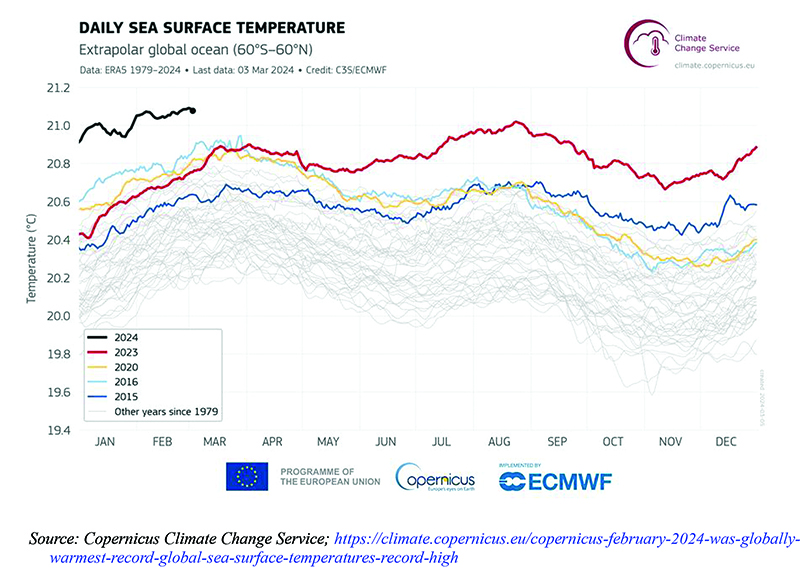My columns argue for rapidly decarbonizing all human activities. Climate tipping points help explain why, and for a report on how close we are to crossing some, I urge watching Johan Rockström’s (2024) TED Talk.
A tipping point occurs when one notch up in temperature crosses a no-return threshold that triggers self-amplifying, possibly abrupt, changes in one of the earth’s climate systems. For example, at some temperature threshold, glacier melting becomes self-reinforcing and unstoppable. No matter what we do after that threshold is crossed, the glacier will melt till it’s gone. Think of leaning back in a chair further and further. You control that chair up to a certain angle. But lean a skinch too far back and the chair takes over (Lenton 2023). Bad for you if it’s your chair; worse for everyone if it’s a glacier.
In 2001, tipping points were not even page 16 news because scientists thought warming had to reach 5°C (9°F) to trigger them, which was an absolute worst-case, century-distant outcome. However, with better climate data, improved resolution of climate systems, and more accurate climate models, tipping points have continued to drop until likely thresholds for the most vulnerable systems now hover around or below 1.5°C (1.8°F). We have moved into the danger zone (Lenton 2019; Rockström 2024).
It gets worse. There are at least 25 tipping points, and many are tightly coupled. Launching one can prematurely trigger a second and the two together can unleash a third resulting in a domino-like cascade, a “spiraling disaster” that can crash food production, collapse nation states, and turn our livable planet into a hot house with temperatures as much as 14°C higher than 1750 (Lenton 2023; Rockström 2024). That could spell near extinction for us because warming will exceed the upper heat limit of the human body for most of the world’s land mass (Vecellio 2023). Want draconian population control? This one makes Malthus a cockeyed optimist.
Which system will tip first? Coral reefs, which support 1 billion people and 25% of all sea life, already face mass bleaching across the tropics, and the unpredicted jump in 2023 sea temperatures which, if continued in 2024 and subsequent years, will spell their early death. Next, we have the West Antarctic and Greenland ice sheets. West Antarctic ice may have already tipped. It was once affixed to submerged rock on a grounding line; that line is now “retreating irreversibly” (Lenton 2019). Greenland ice is faring no better. It’s melting is accelerating and “could be doomed at 1.5°C of warming which could happen as soon as 2030” (Lenton 2019). Finally, large releases of freshwater from Greenland into the Atlantic could shut down the massive Atlantic meridional overturning circulation (AMOC) — perhaps as early as the 2050s or 2060s (Ditlevsen & Ditlevsen 2023) — an outcome that would have catastrophic consequences. AMOC will get its own column.
DAILY SEA TEMPERATURE ABOUT HERE: Where do we stand? To rephrase Tim Walz, it’s late in the fourth quarter, we’re down two touchdowns, and the opposition is moving the ball through our porous defense. Through feats of legerdemain, we must force a fumble, throw a scoring hail Mary, recover an onside kick, pass another hail Mary, and score two on the conversion.
Impossible? Most likely, but I’ll have a playbook next column.
References
- Ditlevsen, Peter & Susanne Ditlevsen. 2023 (Jul 25). Warning of a forthcoming collapse of the Atlantic meridional overturing circulation. Nature Communications; https://www.nature.com/articles/s41467-023-39810-w.pdf
- Lenton, Timothy M., et al. 2019 (Nov 28). Climate tipping points — too risky to bet against. Nature; https://www.nature.com/articles/d41586-019-03595-0
- 2023. Global Tipping Points: Summary Report 2023. University of Exeter, UK; https://global-tipping-points.org/summary-report/narrative-summary/
- Rockström, Johan. 2024 (Aug 15). Tipping Points of Climate Change Where We Stand. TED Talks; https://www.youtube.com/watch?v=Vl6VhCAeEfQ&t=281s
- Vecellio, Daniel J., et al. 2023 (Aug 15). Greatly enhanced risk to humans as a consequence of empirically determined lower moist heat stress tolerance. Proceedings of the National Academy of Sciences; https://www.ncbi.nlm.nih.gov/pmc/articles/PMC10589700/pdf/pnas.202305427.pdf



1 comment for “Heat Waves — In Red & Black: Tipping points make for a planetary emergency”
Recent Comments
Great article and spot on. It’s great to read someone express the truth about the horror we now face with abrupt climate change. Meanwhile, most of the world remains in denial and refuses to see and acknowledge the dark truth. This denial and apathy will be the final nail in the coffin of humanity.